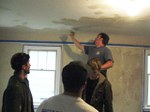A “Sweat Equity” workparty at the Sound Sound Chapter’s Commons EcoHouse. Jeff Thomas of Breathe Easy and local artisan Christopher Gerber collaborated on this project refinishing the main room of our downtown office to make it healthier, and more warm and inviting.
No simple paint job, earthen clay plasters require careful mixing of ingredients with a recipe refined through experience, and a steady hand to apply them. Fortunately, Joseph Becker of Ion EcoBuilding who is an expert on these matters was also on hand to guide us.
Joseph is passionate about using natural local ingredients that have a minimum of processing. This plaster had Kaolin clay, local sand and marble dust, wheat paste and yellow iron oxide for color. The result was a warm golden color with a coarse but lovely texture that reveals the handcrafted nature of the material.
When they did a clay alis on the front office room in June, Jeff and Joseph used clay dug from the raingarden less than 50 feet from where it was applied, again mixed with local sand and wheat paste, but no pigment. The natural brown of our native clay made for a beautiful color on the wall that complements the gold-green color of the kitchen nearby.
Applied as an alis (a 1/8” – 1/4” skim coat applied to existing wallboard or plaster) earthen clay has many advantages over liquid coatings, not the least of which is its extraordinary aesthetic appeal. One has a mysterious sense of comfort upon entering the room, the air just feels different. Explaining the mystery doesn’t change the fact: Earthen plaster moderates humidity and improves indoor air quality. Because it’s permeable, it absorbs moisture when there is an excess in the air and releases moisture when the air is dry. During this cycle earthen plaster releases negative ions that directly enhance human well being, while causing dust and other impurities to clump together and fall to the floor.
Being a natural material, clay plaster is ideal for chemically sensitive people as a least toxic alternative to other coatings. It is fire resistant, yet adds thermal mass to the inside walls holding heat from the sun and releasing it after the sun sets. With the addition of coarse natural fibers such as dried grass, straw or animal hair (not in this case), the clay takes on additional R-value (thermal insulation) while enhancing the texture. This might be seen using a wattle-and-daub application where there is no traditional wallboard; instead reed mats or other material are affixed over framing and insulation, and clay is applied much thicker than an alis, ½” – 1” thick eliminating the need for sheetrock.
As an alternative to paint, even more so when it replaces paint and drywall, earthen plaster has super-low embodied energy and thus is part of the larger climate solution of building long-lasting energy efficient homes.
One might imagine all “green building” to be new technology and innovation. Sometimes, however it is the old technology integrated with new approaches which create the greatest benefit to human health and the natural environment. Natural materials such as earthen clay plasters have been used in Europe for hundreds of years, creating intimate structures which have stood the test of time. Easily repairable using local materials and local knowledge, earthen plasters for home or business have a timeless beauty unmatched by manufactured materials.
When mixed and applied by homeowners, neighbors and friends as part of a work party like we did in this case, the result is participatory building. As Joseph Becker has demonstrated over 15 years of work in our community, “Participation encourages intimacy, intimacy encourages responsibility, responsibility encourages stewardship. More valuable than saving a tree or some energy is increasing our sense of stewardship.”
It’s great to see local painting contractors starting to learn to use this material. The South Sound Chapter expresses deep gratitude to Jeff Thomas of Breathe Easy House Painters who made this project happen, and also to Jesse and Steve from Ketola-Targus Painting who participated.
